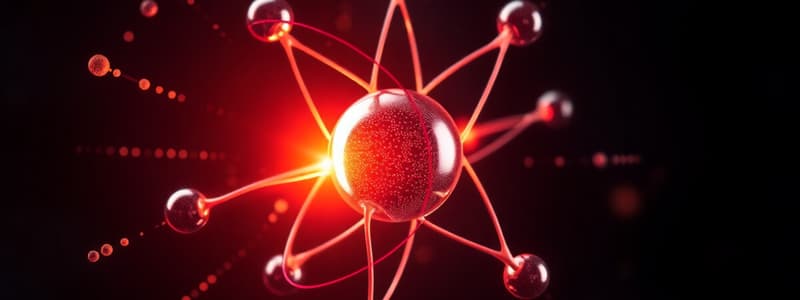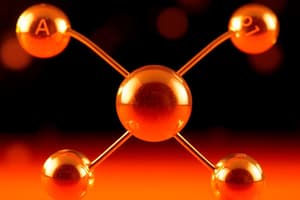Podcast
Questions and Answers
What characterizes a decomposition reaction?
What characterizes a decomposition reaction?
- The rapid oxidation of a substance in the presence of oxygen.
- The exchange of ions between two compounds.
- The breakdown of a complex substance into simpler substances. (correct)
- The replacement of one element in a compound by another.
Which statement accurately describes solids compared to liquids and gases?
Which statement accurately describes solids compared to liquids and gases?
- Solids take the shape of their container.
- Solids can flow like liquids.
- Solids have no fixed volume.
- Solids have a fixed shape and volume. (correct)
Which factor does not affect the solubility of a substance?
Which factor does not affect the solubility of a substance?
- Temperature of the solvent.
- Nature of the solute.
- Pressure applied to the solution.
- Color of the substance. (correct)
What differentiates strong acids from weak acids?
What differentiates strong acids from weak acids?
What is activation energy?
What is activation energy?
Which of the following represents the entropy change of a system?
Which of the following represents the entropy change of a system?
What effect does increasing temperature generally have on a chemical equilibrium?
What effect does increasing temperature generally have on a chemical equilibrium?
What is true about redox reactions?
What is true about redox reactions?
Which is a characteristic of colligative properties?
Which is a characteristic of colligative properties?
What is meant by chemical kinetics?
What is meant by chemical kinetics?
What defines the unique identity of an element?
What defines the unique identity of an element?
What is the role of electron configurations in atoms?
What is the role of electron configurations in atoms?
Which type of bond involves the transfer of electrons?
Which type of bond involves the transfer of electrons?
What principle states that no two electrons can have the same set of four quantum numbers?
What principle states that no two electrons can have the same set of four quantum numbers?
In stoichiometry, what does one mole of a substance correspond to?
In stoichiometry, what does one mole of a substance correspond to?
What type of reaction is characterized by combining substances to form a more complex product?
What type of reaction is characterized by combining substances to form a more complex product?
What technique is used to determine the molar mass of a substance?
What technique is used to determine the molar mass of a substance?
Which of the following describes a characteristic of metallic bonds?
Which of the following describes a characteristic of metallic bonds?
Flashcards
Atomic Structure Basics
Atomic Structure Basics
Atoms are made of a nucleus (protons & neutrons) with electrons orbiting it. Proton number defines the element.
Isotopes
Isotopes
Atoms of the same element with different numbers of neutrons, thus varying atomic mass.
Electron Configuration
Electron Configuration
Arrangement of electrons in energy levels (shells) and subshells (s, p, d, f).
Ionic Bond
Ionic Bond
Signup and view all the flashcards
Covalent Bond
Covalent Bond
Signup and view all the flashcards
Mole Concept
Mole Concept
Signup and view all the flashcards
Stoichiometry
Stoichiometry
Signup and view all the flashcards
Balanced Chemical Equation
Balanced Chemical Equation
Signup and view all the flashcards
Decomposition Reaction
Decomposition Reaction
Signup and view all the flashcards
Single Displacement Reaction
Single Displacement Reaction
Signup and view all the flashcards
Double Displacement Reaction
Double Displacement Reaction
Signup and view all the flashcards
Combustion Reaction
Combustion Reaction
Signup and view all the flashcards
Acid-Base Reaction
Acid-Base Reaction
Signup and view all the flashcards
Redox Reaction
Redox Reaction
Signup and view all the flashcards
Solid State
Solid State
Signup and view all the flashcards
Liquid State
Liquid State
Signup and view all the flashcards
Solution
Solution
Signup and view all the flashcards
Concentration
Concentration
Signup and view all the flashcards
Study Notes
Atomic Structure
- Atoms are the basic building blocks of matter, composed of a nucleus containing protons and neutrons, with electrons orbiting the nucleus.
- Protons carry a positive charge, electrons a negative charge, and neutrons are neutral.
- The number of protons defines the element, and each element has a unique atomic number.
- Atomic mass is the sum of protons and neutrons in an atom.
- Isotopes are atoms of the same element with different numbers of neutrons, leading to variations in atomic mass.
- Electron configuration describes the arrangement of electrons in different energy levels and sublevels around the nucleus. This configuration determines the chemical properties of an element.
- Electron shells represent different energy levels. Electrons in closer shells have lower energy.
- Within each shell are subshells (s, p, d, f), which hold different numbers of electrons.
- The Pauli exclusion principle states that no two electrons in an atom can have the same set of four quantum numbers.
- Hund's rule describes electron filling in orbitals. Electrons will fill degenerate orbitals singly before pairing up.
Bonding
- Chemical bonds hold atoms together in molecules and compounds.
- Ionic bonds form between metals and nonmetals through the transfer of electrons, creating ions (cations and anions).
- Covalent bonds form when atoms share electrons. Polar covalent bonds involve unequal sharing, while nonpolar covalent bonds involve equal sharing.
- Metallic bonds involve the sharing of valence electrons among a group of metal atoms, resulting in conductivity and malleability.
- Intermolecular forces (e.g., hydrogen bonds, dipole-dipole interactions, London dispersion forces) are relatively weak forces between molecules that influence properties like boiling point and solubility.
Stoichiometry
- Stoichiometry deals with the quantitative relationships between reactants and products in chemical reactions.
- The balanced chemical equation represents the proportions of reactants and products in a reaction.
- Mole concept relates the number of particles to mass. One mole of any substance contains Avogadro's number of particles (approximately 6.022 x 10²³).
- Molar mass is the mass of one mole of a substance, expressed in grams per mole (g/mol).
- Calculations involving mass, moles, and volume are essential in stoichiometry problems.
Types of Reactions
- Synthesis reactions involve combining two or more substances to form a more complex product.
- Decomposition reactions break down a complex substance into simpler substances.
- Single displacement reactions involve one element replacing another in a compound.
- Double displacement reactions involve exchanging ions between two compounds.
- Combustion reactions involve the rapid oxidation of a substance, typically in the presence of oxygen, releasing energy.
- Acid-base reactions involve the transfer of protons (H+) between reactants.
- Redox reactions involve the transfer of electrons between reactants.
States of Matter
- Matter exists in solid, liquid, and gaseous states.
- Solids have fixed shape and volume, liquids have fixed volume but take the shape of their container, and gases have neither fixed shape nor volume.
- Phase transitions (melting, freezing, vaporization, condensation, sublimation, deposition) occur at specific temperatures and pressures.
- Kinetic molecular theory explains the behavior of matter in terms of the motion of its particles.
- Pressure is the force exerted per unit area of a surface.
- Temperature is a measure of the average kinetic energy of the particles in a substance.
Solutions
- A solution is a homogeneous mixture of two or more substances, where one substance (solute) is dissolved in another (solvent).
- Concentration refers to the amount of solute dissolved in a given volume of solvent.
- Concentration can be expressed in various units, such as molarity (moles/liter), molality (moles/kilogram), or percent by mass.
- Solubility is the maximum amount of solute that can dissolve in a given solvent at a specific temperature and pressure.
- Factors affecting solubility include temperature, pressure, and the nature of the solute and solvent.
- Colligative properties of solutions depend on the concentration of solute particles, not their identity.
Acids and Bases
- Acids have a sour taste, react with bases to form salts and water, and can often dissolve metals.
- Bases have a bitter taste, feel slippery, and react with acids to form salts and water.
- pH is a measure of the concentration of hydrogen ions (H+) in a solution. A lower pH indicates a higher concentration of H+ and thus a more acidic solution.
- Strong acids and bases completely dissociate in water; weak acids and bases partially dissociate.
- Buffers resist changes in pH by neutralizing added acid or base.
Kinetics
- Chemical kinetics studies the rates of chemical reactions.
- Reaction rate is the change in concentration of a reactant or product per unit time.
- Factors affecting reaction rate include reactant concentration, temperature, presence of a catalyst, and surface area.
- Activation energy is the minimum energy required for a reaction to occur.
- Reaction mechanisms describe the step-by-step process by which a reaction occurs.
Thermodynamics
- Thermodynamics studies energy changes in chemical and physical processes.
- Enthalpy (ΔH) is a measure of the heat absorbed or released in a reaction at constant pressure.
- Entropy (ΔS) is a measure of the disorder or randomness of a system.
- Gibbs free energy (ΔG) is used to determine whether a reaction is spontaneous under given conditions.
Equilibrium
- Chemical equilibrium is a state where the rates of the forward and reverse reactions are equal, and there is no net change in concentrations of reactants and products.
- Equilibrium constant (K) quantifies the relative amounts of reactants and products at equilibrium.
- Le Châtelier's principle describes how a change in conditions (e.g., temperature, pressure, concentration) affects a chemical equilibrium.
Redox Reactions
- Redox reactions involve the transfer of electrons between reactants.
- Oxidation is the loss of electrons, and reduction is the gain of electrons.
- Oxidizing agents cause oxidation in another substance, and reducing agents cause reduction in another substance.
- Oxidizing and reducing agents are essential for understanding chemical processes and reactions in various fields, like electrochemistry and combustion.
Studying That Suits You
Use AI to generate personalized quizzes and flashcards to suit your learning preferences.




